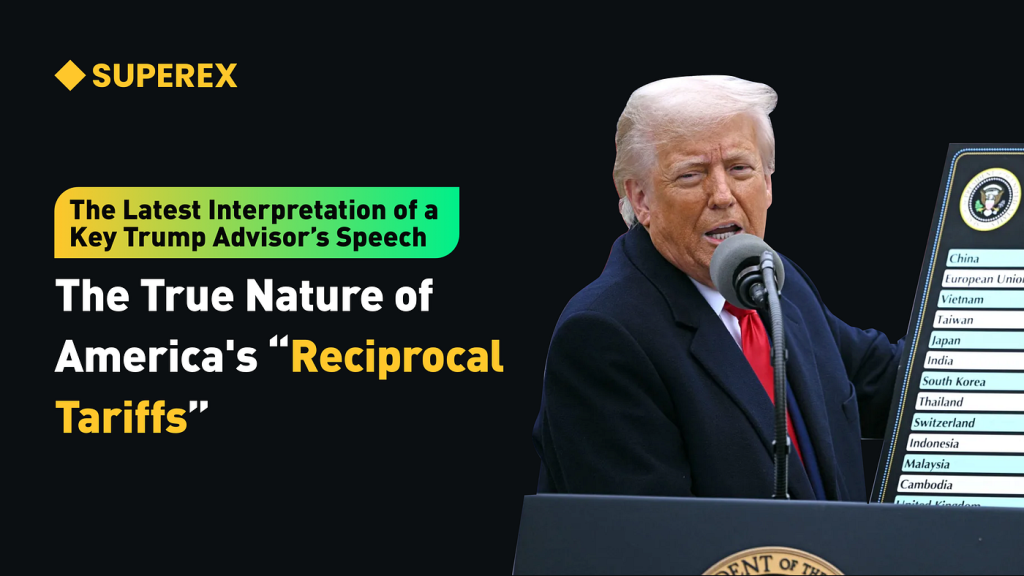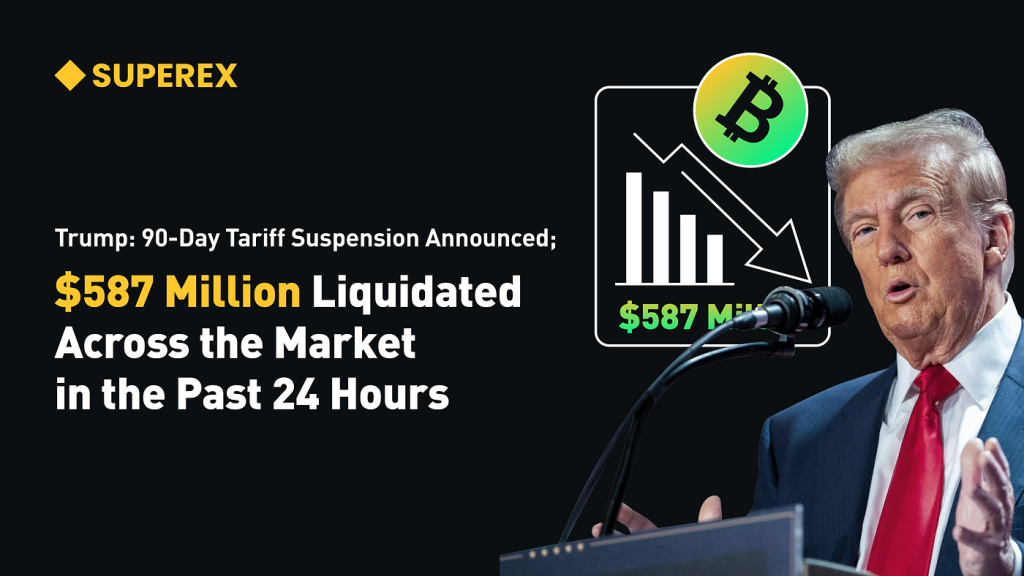How should crypto businesses and investors respond as Trump’s tariffs are about to take effect?

#Trump #Crypto #SuperEx
On April 2nd, the impending tariff policy in the United States has triggered a shockwave through global finance, much like the Sword of Damocles hanging overhead. Although the fundamental reason behind Trump’s tariff hike is to wage an “economic trade war” at the national level — in simple terms, whichever country taxes American goods, he reciprocates by imposing the same or even higher tariffs on their imports.
In today’s hyper-connected global economy, any trade conflict triggers a chain reaction. Tariffs, once enacted, first strike supply chains. The added costs cascade down the production ladder, ultimately landing on the shoulders of end consumers. Simply put, the burden always trickles down to the public.
Of course, some might think that consumer and supply chain issues have little to do with the crypto industry. But remember, in today’s world of total interconnection, no industry or field can remain isolated from reality. For the crypto sector, especially cryptocurrencies, once the tariff policy is implemented, the rise in global supply chain costs and the increased burden on consumers will stimulate market risk aversion.
For the crypto industry, heightened risk aversion means that some capital will seek to escape the uncertainties of traditional financial markets and move towards strong, stable assets. The optimal choice is naturally gold, followed by what is often called the “digital gold” — Bitcoin. If you have been paying attention to the gold market recently, you may have noticed that gold prices have been rising. Even though they experienced a brief dip a few days ago, they quickly rebounded and have continued to trend upward.
Keep in mind that market reactions always precede reality. Next, we will analyze from multiple perspectives how crypto businesses and investors should respond to the implementation of Trump’s tariff policy.
- Click to register SuperEx
- Click to download the SuperEx APP
- Click to enter SuperEx CMC
- Click to enter SuperEx DAO Academy — Space

The Deeper Impact of Tariff Policies and Risk Aversion Effects
First and foremost, whether it’s an escalation of trade wars or a disruption in supply chains, global capital market confidence will inevitably take a hit. In the short term, protectionist trade policies can trigger market panic, leading investors to offload risk assets and seek relatively safe haven tools. Historical data has shown that under the combined pressures of geopolitical risks, weak economic data, and trade frictions, traditional financial markets often experience capital outflows, with the stablecoin market, represented by Bitcoin, becoming a primary target for funds seeking refuge.
After the tariff policy is enacted, the uncertainty of the global economy will rise, increasing the demand for safe-haven assets. This could potentially drive short-term price increases in crypto assets. At the same time, due to changes in the liquidity of capital markets, the volatility of the crypto market will likely intensify. For the digital currency market, this situation may result in more benefits than drawbacks.
Supply Chain and Operating Cost Transmission: Forcing Miners to Adjust Strategies
Although most crypto companies are technology-centric, aspects like hardware manufacturing, server procurement, and data center construction are still closely tied to the global supply chain. The rise in tariffs will increase the cost of related hardware equipment, which may force some enterprises to restructure their supply chains, seeking regional suppliers to reduce dependence on global trade fluctuations.
Moreover, some crypto mining equipment manufacturers and hardware production companies may face cost pressures, compelling them to increase product prices or transfer part of the cost risk.
One real-world example comes from Ben Ganon, CEO of the Canadian Bitcoin mining company Bitfarms. In an interview with Bloomberg, he stated that while recent energy price increases have had little impact on the company’s current business, future policy and regulatory frameworks could indirectly influence Bitfarms’ industrial layout. Ganon expressed the company’s desire to see “more access to power markets” as part of future strategies.
How the Crypto Industry Can Benefit from Tariffs
1. Capital Flow and Market Sentiment Fluctuations
Driven by the inflow of safe-haven funds, the crypto market may experience a short-term surge in capital. For well-capitalized crypto trading platforms and asset management companies with strong risk management capabilities, this presents a great opportunity to expand market share. At the same time, some startups and innovative projects might also attract investor interest, accelerating the integration and upgrading of the entire industry chain.
2. Promoting Digitalization of Cross-Border Payments and Trade
As tariff policies drive up the cost of cross-border trade, the advantages of cryptocurrencies and blockchain technology become increasingly apparent when businesses seek new ways to reduce international transaction frictions. Utilizing digital currencies for cross-border payments can bypass the high fees and time delays associated with traditional banking, prompting more enterprises to explore blockchain applications in trade finance, supply chain management, and other areas. In the long run, as trade digitalization and supply chain intelligence advance, cryptographic technology and financial services are expected to become key supports in the process of reconstructing global trade.
Promoting Financial Innovation and Decentralized Finance (DeFi) Development
The macroeconomic uncertainties caused by tariffs and trade wars will drive market participants to seek new financial tools to diversify risks. Against this backdrop, the DeFi ecosystem has garnered significant attention by leveraging technologies like smart contracts to deliver intermediary-free, transparent, and trustworthy financial services. The global economic fragmentation and confrontational sentiment triggered by tariffs may accelerate the development of DeFi projects, enabling them to play a more significant role in cross-border settlements, asset management, lending, and other areas, thereby bringing more practical applications and capital inflows to the crypto industry.
3. Supply Chain Risks Drive Regional Crypto Applications
Tariff policies often force multinational companies to reconsider and optimize global supply chain layouts. In this process, businesses may increasingly rely on local or regional solutions. As a result, localized crypto projects and blockchain applications — such as supply chain traceability and logistics management — may receive more policy support and market opportunities, thereby accelerating the development of related technologies and services.
4. Leveraging Low-Cost Energy: Competitive Advantage for Miners
As the U.S. imposes tariffs on steel, aluminum, and other industrial products, the policy aims to encourage the reshoring of domestic manufacturing. However, this measure inadvertently brings unexpected strategic opportunities for Bitcoin miners.
Miners, although unable to control Bitcoin prices, can control power costs and optimize energy resources, turning them into proactive market competitors.
- Low-Cost Power Supply
Miners are targeting regions with abundant and low-cost electricity, such as parts of Pennsylvania, once a hub of heavy industry. As traditional manufacturing declines, unutilized power resources remain, allowing Bitcoin miners to lease or acquire infrastructure assets, achieving cost-effective and efficient mining.
- Asset Revaluation and Capital Dividend
As U.S. policies encourage manufacturing reshoring, heavy industrial infrastructure that was once outsourced may receive new market recognition. By investing in these facilities, Bitcoin miners not only benefit from sustainable low-cost energy, but also position themselves to profit from asset revaluation.
When manufacturing recovers, these strategic infrastructure assets will become increasingly valuable, and miners who have invested early stand to gain significantly from both operational cost savings and capital appreciation.
Conclusion
As Trump’s tariff policy is about to take effect, this event will not only disrupt global supply chains and increase consumer costs but also exacerbate risk aversion sentiment in financial markets to some extent. For the crypto industry, this environment may attract safe-haven capital to flow into digital asset markets, leading to short-term market fluctuations.
In light of this situation, crypto businesses and investors should adopt a multi-dimensional approach to risk management, asset allocation, and strategic planning. It is crucial to remain vigilant about the risks posed by market volatility while also seizing strategic opportunities created by the growing global economic uncertainty.
In summary, the implementation of Trump’s tariffs may usher in a brief period of safe-haven capital inflow for the crypto market, but it also sounds an alarm for global economic recovery and industrial restructuring. In the face of an uncertain future, we must adopt a strategic perspective on short-term fluctuations, rationally analyze changes in the global economy and financial markets, and truly achieve risk prevention, opportunity capture, and steady progress.







Responses